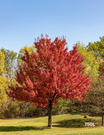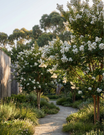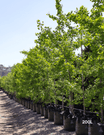Creating a stunning garden avenue or allée lined with symmetrical trees is a timeless way to make a grand impression. These carefully structured rows of trees frame walkways, driveways, or even the entrance to a grand home, creating a striking visual experience. But which trees should you choose for such a significant project? Here, we'll explore the best options for your garden avenues and allées, focusing on tree species that combine elegance with low maintenance, perfect for creating a luxurious, lasting impression. Let’s dive into the key features of three standout species: Tilia cordata (Small-Leaved Lime), Platanus x acerifolia (London Plane), and Acer campestre (Field Maple).
Tilia cordata (Small-Leaved Lime)
For those seeking a tree that exudes subtle charm, Tilia cordata is an excellent choice. Known for its dense foliage and heart-shaped leaves, this tree offers a clean, symmetrical form perfect for lining garden paths or driveways. Not only does it provide visual beauty, but it also attracts pollinators such as bees, adding a lively buzz to your garden in the warmer months. Its uniform shape and dense canopy make it ideal for those looking to create shaded, serene avenues with an almost regal feel.
Key Facts:
- Mature Height: 15-25 meters
- Mature Width: 6-10 meters
- Best Uses: Lining walkways, garden avenues, or creating shaded, symmetrical allées
- Leaf Appearance: Small, heart-shaped leaves that turn a golden yellow in autumn
- Rate of Growth: Moderate
- Tolerates: Urban pollution, clay soils, and full sun to partial shade
Why It’s Perfect to Add to Your Garden
Tilia cordata adds a sense of structure and elegance to any garden with its clean, formal appearance. Its versatility makes it suitable for both large estates and smaller luxury gardens. This is an excellent choice if you're looking for a tree that offers a stunning visual impact in all seasons. During spring and summer, the tree is lush with dark green leaves, while autumn brings a vibrant display of yellow foliage, creating a seasonal spectacle. Its resilience in urban environments and tolerance to different soil types make it a practical, low-maintenance option for high-end landscapes.
Platanus x acerifolia (London Plane)
Known for its iconic peeling bark and robust stature, the Platanus x acerifolia is often found gracing grand avenues in cities and estates alike. This hybrid tree blends American sycamore and Oriental plane trees, resulting in a hardy, disease-resistant species that thrive in various conditions. Its impressive height and broad canopy make it ideal for creating majestic, shaded avenues that make a powerful statement.
Key Facts:
- Mature Height: 20-30 meters
- Mature Width: 15-20 meters
- Best Uses: Grand avenues, driveway lining, and large formal landscapes
- Leaf Appearance: Large, lobed leaves that transition to a soft golden brown in autumn
- Rate of Growth: Fast-growing
- Tolerates: Urban pollution, drought, and heavy pruning
Why It’s Perfect to Add to Your Garden
If you aim for a bold, impressive look, Platanus x acerifolia is your go-to tree. Its massive size and ability to thrive in polluted or challenging conditions make it ideal for urban environments or expansive estates. The exfoliating bark, which reveals green, cream, and grey patches, adds an artistic touch to the landscape, making this tree a year-round feature. With its broad leaves providing ample shade, it's perfect for creating cool, tranquil pathways during the summer months. Its fast growth ensures that your garden allée or avenue will reach maturity relatively quickly, providing that grand, stately look in no time.
Acer campestre (Field Maple)
The Acer campestre, or Field Maple, offers a more modest yet equally captivating option for garden avenues. This compact deciduous tree is known for its attractive, finely lobed leaves that turn a brilliant yellow in autumn. Its compact size makes it suitable for more intimate allées or avenues where space may be limited, but the desire for beauty is still paramount. Acer campestre thrives in various soil types and is incredibly hardy, making it a reliable and enduring choice for sophisticated gardens.
Key Facts:
- Mature Height: 10-15 meters
- Mature Width: 6-8 meters
- Best Uses: Narrow avenues, smaller garden paths, and ornamental avenues
- Leaf Appearance: Small, lobed leaves that turn from green to a radiant yellow in autumn
- Rate of Growth: Slow to moderate
- Tolerates: Drought, wind, and a range of soil types, including poor soils
Why It’s Perfect to Add to Your Garden
For a more understated yet refined avenue, the Acer campestre is a fantastic option. Its smaller stature makes it perfect for lining narrower pathways or use in more modestly sized gardens where space is a concern. Despite its compact size, this tree offers a stunning seasonal display, with golden autumn leaves that brighten any garden. It’s also incredibly tolerant of various environmental conditions, including poor soils and drought, making it a low-maintenance choice that will thrive with minimal intervention. If you’re looking for a tree that combines beauty with resilience, the Field Maple will not disappoint.
Tips for Planting and Maintaining Garden Avenues
When planting trees for avenues or allées, symmetry and spacing are critical. Here are some key considerations to ensure your avenue is visually stunning and long-lasting:
- Spacing: The distance between trees will depend on the species, but a general rule of thumb is to space trees 4-8 meters apart, depending on their mature width. This allows each tree to grow to its full potential without overcrowding.
- Planting Depth: Ensure trees are planted at the same depth as in their nursery containers. Avoid planting too deeply, as this can suffocate the roots.
- Irrigation: Newly planted trees require consistent watering, particularly in the first few years. An irrigation system is highly recommended to maintain tree health in larger garden avenues.
- Pruning: Regular pruning is essential to maintain the desired shape and symmetry of the avenue. For formal avenues, pruning may need to be done annually or biannually to control growth and ensure an even canopy.
Frequently Asked Questions
How far apart should trees be planted in an avenue?
The spacing will depend on the tree species and the desired effect. For smaller trees like Acer campestre, 4-6 meters apart is ideal, while larger species like Platanus x acerifolia may require 6-8 meters for their broad canopy.
Are these trees high maintenance?
Once established, all three species mentioned are relatively low-maintenance. Tilia cordata and Acer campestre require minimal pruning, while Platanus x acerifolia may need more regular care to maintain its impressive structure.
Can these trees thrive in urban environments?
Yes, Platanus x acerifolia and Tilia cordata are known for their tolerance to urban pollution, making them excellent choices for city landscapes or gardens near busy roads.
Conclusion
Creating a stunning avenue or allée is a beautiful way to elevate the design of any garden. Whether you choose the stately Platanus x acerifolia, the refined Tilia cordata, or the charming Acer campestre, each tree offers unique benefits that will transform your landscape. With proper planning and maintenance, your tree-lined pathway will offer years of beauty, shade, and elegance, making it a worthy addition to any luxury estate or high-end garden.




















































Leave a comment
This site is protected by hCaptcha and the hCaptcha Privacy Policy and Terms of Service apply.